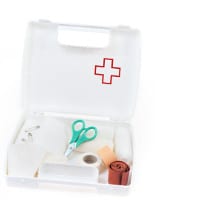Accidents happen. While we try to keep our families as safe as possible, inevitably, someone is going to get hurt.
The Red Cross recommends preparing for any emergency with a well-stocked first aid kit on hand—both at home and in the car. Build your best defense against a bad boo boo with these expert items.
First Aid Kits: The Essentials
- Pain relievers: acetaminophen or ibuprofen, but never give aspirin to anyone under age 18.
- Sterile water or saline.
- Allergy medications including fast-acting chewable medications or an EpiPen if someone in your family requires one.
- Tools, including tweezers, scissors and a thermometer.
- Sterile bandages and cloths.
- Antibiotic and cortisone creams or ointments.
- Gauze and tape.
- Sterile gloves and antiseptic wipes.
Salvage a Scrape or Cut
Most cuts and scrapes don’t mean a visit to the ER, say experts at the Mayo Clinic. Instead, try these simple steps:
1. Stop bleeding by applying a clean bandage or cloth to a wound and holding for 20-30 minutes. Don’t keep checking to see if the bleeding has stopped. Call 911 if the bleeding spurts or continues even under pressure. Jagged or deep wounds require stitches.
2. In the absence of bleeding, clean a wound or scrape with clear water only. Use tweezers dipped in rubbing alcohol to remove any visible debris. Avoid soap, hydrogen peroxide or any iodine products, which will only irritate a wound.
3. Apply an antibiotic cream or ointment to help prevent infection. Stop using the antibiotic product if a red rash appears.
4. Cover the wound with a bandage to keep it clean, and change the dressing and bandage at least daily or anytime it becomes dirty or wet.
5. As soon as the wound appears to be healing, allow it to be exposed to open air to help it heal faster.
6 Watch for infection—pain, warmth, redness or draining oozing from the wound. See a healthcare provider if you see fever or these signs.
Aid a Burn
Minor burns without blisters or broken skin can be treated at home, says the Red Cross. But if blisters or fever emerge, see a healthcare provider.
1. Soak the burn area with cool water—not iced water.
2. Cover the burn with a cold, clean cloth.
3. Keep the burn free from any pressure, rubbing or touching.
4. Use ibuprofen or acetaminophen for pain.
5. Watch for infection—pain, warmth, redness or draining oozing from the burn. See a healthcare provider if you see fever or these signs.
6. Avoid butter, ice, fluffy cotton dressings, bandages, creams, oils, sprays or any household remedy supposedly for burns—these do not work and can make the wound worse.






Comments are closed.